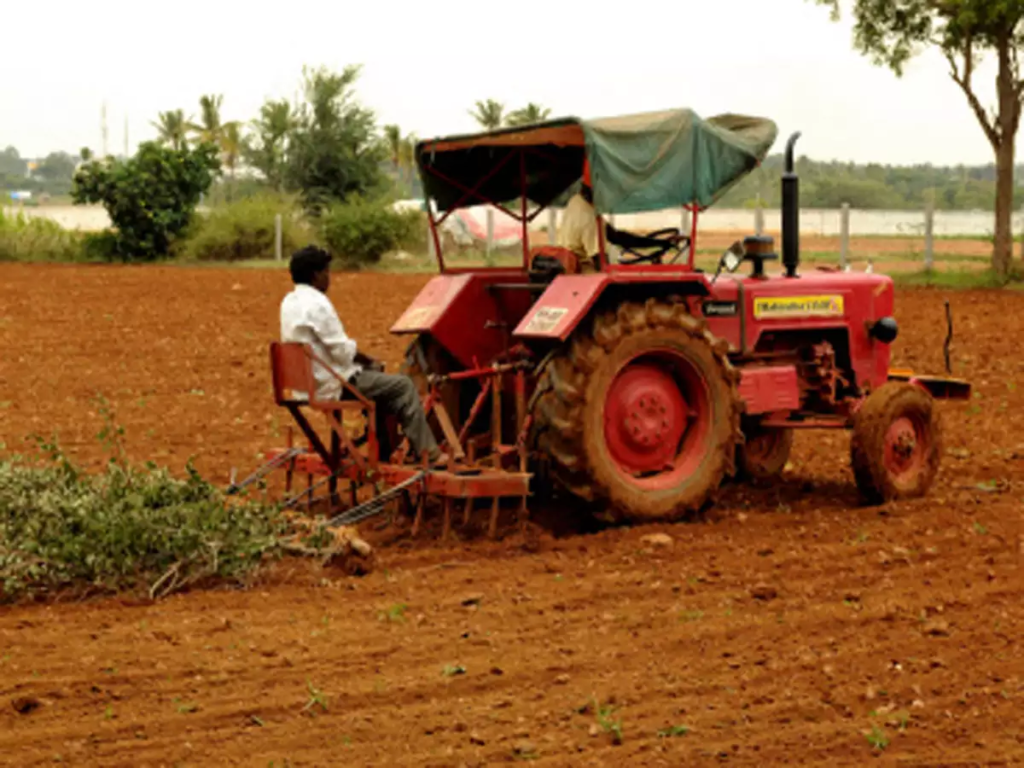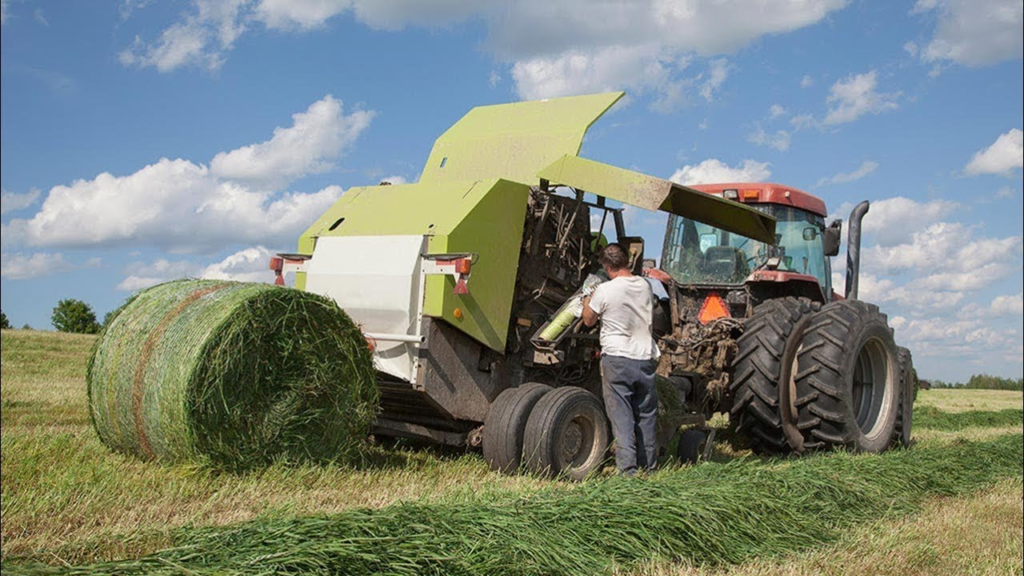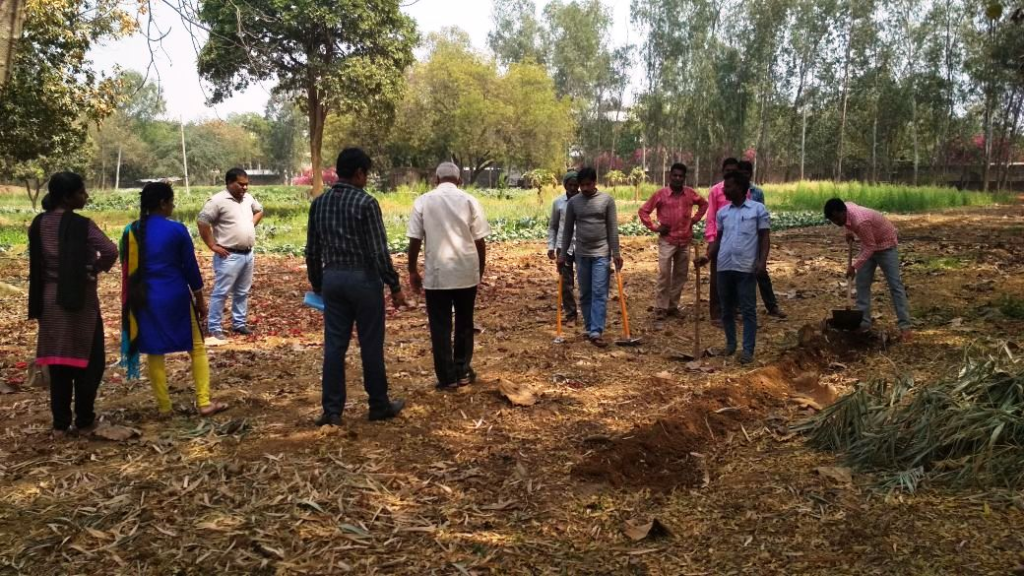Tractor Mechanic

Tractor Mechanic manages to repair and maintain the various parts of the tractor. Short Term Description: Tractor Mechanic conducts regular checks, performs repair and repair of engine parts and repaired parts and services, checks for transmission, power systems and self-contained electricity, etc. ability. They must also have problem-solving, problem-solving and decent communication skills. Must know the basic functions of a tractor Tractor Mechanic.

Prepare for carrying out tractor repair and maintenance Tractor Mechanic:
PC1. identify the types of tractors, parts and agricultural / commercial applications PC2. identify, understand and monitor the functioning of the following: types of dunes (single, dual and independent) and operational procedures active and types of gearbox abdomen front and rear wheels steering and positioning systems wheels and tires brakes (immersed in oil and oil) tractor electric system ( charging, starting, wiring, metal assembly) types of hydraulic system PC3. measure field testing and evaluate fuel consumption, coverage and depth Find and learn the various tools and attachments and their use In order to be effective, the user / individual must be able to, PC4. point to the different uses of tractors – agricultural and non-agricultural PCs. identify and learn the various methods of cultivating harvesting tools / harvesters – harvesters, harvester etc., select the installation as an individual tractor by testing the tractor compared to the PC7 compatible installation. hitch and repair tools with a tractor Tractor Mechanic.
PC8. drive and operate a tractor with and without equipment Identify the tools and tools needed To be competent, a user / individual must be able to make a PC9. identify the tools needed to separate and assemble the various PC10 tractor systems. identify and select the measurement tools and equipment needed to repair and repair PC11. identify and select marking tools and special service tools recommended by OEM
Organizational Context (Knowledge of the company / organization and its processes) Tractor Mechanic:
The user / person at work needs to know and understand: KA1. business code of conduct KA2. job and employment obligations KA3. standard repair and tractor procedures
Technical Knowledge:
The user / person at work needs to know and understand: KB1. Special tools for OEMs, special OEMs for staining KB2. Types of tractors, their variations and the use of KB3. basic engine names, transmission systems, compression systems and KB4 power systems. construction, operating and operating conditions of the tractor KB5. the types of tools and equipment needed to repair and maintain KB6. change the width of the wheel track with different operating conditions KB7. water and weight ballasting KB8. various agricultural and non-agricultural uses and uses KB9. various instruments for accurate measurement KB10. types of measurement tools and its use of KB11. the use of instruments such as micrometer, (outside, inside, depth, with screw thread), Vernier caliper, dial caliper, dial test indicator, size gauge, screw pitch gauge, sheet and gauge gauge KB12. the use of standard hand tools KB13. wheel pressure required in various systems KB14. common faults and tractor repair procedures KB15. use of tractors in standing, commercial and industrial systems KB16. binding and connecting tools used KB17. trailer hitch height of different wheels of trailer KB18. weight transfer similar to the previous weight, the need for mast height KB19. hazardous machinery (law), law 1983
Core Skills/ Generic Skills:
The user / person at work needs to know and understand how to do this: SA1. note the details referred to SA2. Note that the equipment to be used The user / person at work needs to know and understand how to do it: SA3. read and interpret the required process of preparation and maintenance Oral communication (listening and speaking skills) The user / person at work needs to know and understand how to do this: SA4. communication with customers, farmers and members of the SA5 team. listen to and understand the information provided by the SA6 speaker. communication problems B. Practicing Professional Skills The user / employee needs to know and understand how to do it: SB1. manage issues related to equipment and equipment and decide on remedial action to be planned Plan and edit The user / person at work needs to know and understand how to do this: SB2. edit and edit work based on instructions received by SB3. plans to use Customer Centricity of time and equipment The user / person at work needs to know and understand that: SB4. understand customer needs and priorities and respond according to their needs Solving Problems A user / employee needs to know and understand: SB5. ensure error detection and remedial consultation in consultation with key stakeholders such as farmers and team members. use domain information about maintenance procedures and technical information on tools and equipment Key considerations The user / employee needs to know and understand: SB7. use common sense and make daily decisions Tractor Mechanic

Perform necessary routine checks and maintenance of the tractor Tractor Mechanic:
In order to be effective, each user / individual must be able to: PC1. read the manufacturer’s manual, maintenance schedule and understand the specifications of PC2 components and accessories. perform regular tractor maintenance (10 hours, 50 hours, 100 hours, 250 hours, 500 hours and 1000 hours) PC3. road test tractor to test engine performance, clutch, gears, brakes and PC4 steering. testing the performance of tools such as harrow, rotavator, seed drills, etc. PC5. make checks for fan band bands and switch Make fluid and lubricant checks To be effective, each user / individual must be able to: PC6. check oil level and engine leaks, air cleaner, gearbox, rear axle and PC7 steering. replace engine oil filter, turbo filter, fuel filter and hydraulic PC8 filter. check radiator coolant / pool tank PC9. check any bleeding or air key on the PC10 fuel system. check electrolyte battery level Check the performance of all gauges To be effective, the user / individual must be able to: PC11. check that the correct temperature is maintained in the PC12 gauge. check the proper oil pressure PC13. check if the hour meter has been changed
Organizational Context (Knowledge of the company / organization and its processes):
The user / person at work needs to know and understand: KA1. business code of conduct KA2. job and employment obligations KA3. procedures and procedures for making general checks on tractor parts Tractor Mechanic.

Technical Knowledge:
The user / person at work needs to know and understand: KB1. how to repair and repair the tractor as instructed by the operator KB2 manual. service and inspection before, during and after the start of the tractor KB3. details of construction of various tractor systems KB4. performance of various KB5 engine systems. types of brakes, lashes and adjustment systems KB6. automatic power system and its use on a KB7 tractor. four wheels, hydraulic and power removes KB8. various pulley sizes of compressor and application thresher KB9. driving a tractor with different equipment KB10. hazardous machinery (law), law 1983
Core Skills/ Generic Skills:
The user / person at work needs to know and understand how to do this: SA1. note the details referred to SA2. be aware of the tools and equipment that will be used Learning Skills The user / person at work needs to know and understand how to do this: SA3. read and interpret the required process of preparation and maintenance Oral communication (listening and speaking skills) The user / person at work needs to know and understand how to do this: SA4. contact with farmers and members of the SA5 team. listen to and understand the information provided by the SA6 speaker. communicate with the challenges they face. B. Practicing Professional Skills The user / employee needs to know and understand how to do this: SB1. manage issues related to equipment and equipment and decide on remedial action to be planned Plan and edit The user / person at work needs to know and understand how to do this: SB2. edit and edit work based on instructions received by SB3. plans to use time and resources Customer Consumer The user / person at work needs to know and understand that: SB4. understand customer needs and priorities and respond according to their needs Solving Problems
The user / person at work needs to know and understand how to do it: SB5. ensure appropriate diagnostics and solutions by consulting with key stakeholders such as farmers and team members. use domain information about maintenance procedures and technical information on tools and equipment Key considerations The user / employee needs to know and understand: SB7. use common sense and make daily decisions

Carry out overhauling and repair of engine parts Tractor Mechanic:
In order to be effective, each user / individual must be able to: PC1. identify the types of engines and their components PC2. identify and understand PC3 engine performance. arrange all the necessary requirements for the disassembly process such as tools, wooden blocks, protective clothing, etc. PC4. follow the prescribed disassembly procedures as described in the PC5 manual. clean broken parts / bottles of broken PC6. keep stripped parts in a safe and dust-free PC7. perform visual inspections of all PC8 components. check RPM idle engine and RPM PC9 idle. check the performance of the following engines: fuel system lubrication system cooling system air intake and PC10 exhaust system. disassemble and check the cylinder head, and check if it needs PC11 replacement. check water temperature, senators, wiring, gauge, PC12 thermostat. inspect the engine before and after the oil seal and check if they need PC13 replacement. remove, dial and reassemble radiator Analyze engine components and create troubleshooting To be able to work properly, each user / individual must be able to: PC14. check for common breakdowns and determine if parts will be replaced or repaired by PC15. check the softness and durability of the cylinder bore PC16. check engine pressure process, turbo charger, and PC17 gas discharge systems. check the maturity of crank shaft / bearings PC18. measure the width of the piston rings and the spacing of the rings

PC19. measure and check the side clearance of piston PC20 rings. check for wear and tear on PC21 valves. check spring tightness of valves and change in clarity of PC22. check the permit between gear and oil pump PC23. fix defective parts using hand tools, welding, mills, saws and other PC24 tools. shooting problem in the event of something wrong with the engine parts
Organizational Context (Knowledge of the company / organization and its processes):
The user / person at work needs to know and understand: KA1. business code of conduct KA2. job and employment obligations KA3. safety measures to be taken during operation KA4. general disassembly procedures followed by the organization Tractor Mechanic
Technical Knowledge:
The user / person at work needs to know and understand: KB1. construction, operating conditions and operation of tractor engines KB2. various engine parts, their construction details, materials used for engine parts, assembling and dismantling engine parts, and cleaning, repairing, replacing their KB3. disassembly sequence, reassemble with all critical settings such as valve approval, time gears, FIP timing pump line and rotary pump KB4. measuring tools such as feeler gauge, fillet radius gauge, Vernier, micrometer, dial gauge, dial bore gauge KB5. torque, back-up torque, power and its components and performance of the KB6 diesel engine. the operating principle of the fuel supply system includes the inline fuel injection pump and rotary pump system KB7. removal, removal and reassembly of the radiator engine KB8. engine valve operation equipment KB9. management and use of operational tools (including specialized equipment) and KB10 equipment. Various engine systems such as ventilation and exhaust system, fuel supply system, cooling system, lubrication system, KB11 control system. engine and their KB12 troubleshooting. modified engine testing system KB13. hazardous machinery (law), law 1983 Tractor Mechanic
Core Skills/ Generic Skills:
The user / person at work needs to know and understand how to do this: SA1. note the details referred to SA2. be aware of the tools and equipment to be used The user / person at work needs to know and understand how to do it: SA3. read and interpret the required process of oral communication (listening and speaking skills) The user / person at work needs to know and understand how to do this: SA4. communication with customers, farmers and members of the SA5 team. listen to and understand the information provided by the SA6 speaker. communicate with the challenges they face. B. Practicing Professional Skills The user / employee needs to know and understand how to do this: SB1. manage issues related to equipment and equipment and decide on remedial action to be planned Plan and edit The user / person at work needs to know and understand how to do this: SB2. edit and edit work based on instructions received by SB3. plans to use time and resources Customer Consumer The user / person at work needs to know and understand that: SB4. understand customer needs and priorities and respond according to their needs Solving Problems A user / employee needs to know and understand: SB5. ensure appropriate diagnostics and solutions by consulting with key stakeholders such as farmers and team members. use domain information about maintenance procedures and technical information on tools and equipment Key considerations The user / employee needs to know and understand: SB7. use common sense and make daily decisions


Carry out overhauling and repair of transmission, hydraulic and tractor-electrical systems Tractor Mechanic:
In order to be effective, each user / individual must be able to: PC1. disassemble and assemble the transmission system according to the manufacturer’s recommendation and using the appropriate PC2 hand tools. check and adjust the functionality and function of the clutch, gearbox, rear axle, power outlet, brakes and hydraulic system PC3. to solve the problem if something is not compatible with PC4. check free clutch play setting, finger height suspension, clutch alignment and PC5 plate. check for degradation of various parts of the clutch: flywheel grip plate pressure plate grip springs finger attachment shooting problem if there is something wrong with Clutch PC7. check the reasons for the noisy gear, gear slip, oil leak on the PC8 gearbox. complete and test the operation and operation of the PC9 gearbox. check gear ratio, torque rating, and gear types used in gearbox PC10. trouble shooting in case something goes wrong with the Gear PC11 box. check and adjust the front wheel hub for PC12 play. check all nuts and bolts and PC13 hardness. adjust the geometry of the steering (inner toe, toe out, camber angle, caster angle and kingpin inclination) and perform problem solving for steering system PC14. check disc brakes (immersed with oil), their performance and maintenance and perform problem solving including installing brake shoes and replacement for free PC15 gaming. make sure the correct brake and clutch change and make sure the brakes are on again Tractor Mechanic
free play habits are well adjusted for PC16. make sure the laity paddle latch is active while driving on PC17 road. make wheel track change PC18. check the performance and function of the rear-axle axle, the last reduction-bull and pinion, epiclike (planetary reduction unit) and PC19 wheels. check axle shaft, oil bearings for bearings and change where PC20 is required. shooting problem in the event of something wrong with the rear axle of PC21. check the steering system – on the mechanical drive box, connectors on the moto steering – steering wheel (steering unit), steering cylinders and PC22 connections. shooting problem in the event of a malfunction of the control system and electrical power PC23. disassemble and inspect the front 2wd pin – integrated pin, axle axle and PC24 wheel assembly. shooting problem in the event of something wrong 2wd in front of the PC25 axle. disassemble and check the 4 wad front of the asi-drop box, propeller shaft, contrast, shaft shaft & wheel assembly PC26. shooting problem in case something goes wrong 4wd in front of the PC27 axle. watch the inflation pressure on the wheel as the use of a PC28 tractor. inspect the tires for any piercings and proceed with the installation. complete the compression program according to the manufacturer’s recommendations and by using the appropriate hand tools for PC30. inspect and repair parts and operation of hydraulic pump PC31. inspect the components of the hydraulic distributor and hydraulic cylinder and detect errors for PC32. check parts of PC33 compression pipes. check and adjust the performance of the adjustment control and condition control hydraulic PC34. check oil pressure pressure and check PC35 critical connection. check the operation and performance of the hydraulic system pressure and perform PC36 problem solving. check the performance of the future (external hydraulic valve) PC37. check the lifting method (three-point connection) of the PC38 tractor tools. shooting in case of malfunction in hydraulic Detection, dismantling, inspection and repair of tractor and electrical system In order to operate properly, the user / individual must be able to: PC39. check the PC40 battery performance and performance. check the operation of various gauges on a metal panel such as RPM gauged, hour meter, fuel gauge, battery charging indicator, air filter filter indicator, etc. and PC41. check the operation and performance of the alternator / dynamo and self starter Tractor Mechanic
PC42. check the functionality and functionality of the PC43 control system. view the functionality and functionality of the program to start, transfer and format PC44. check the performance of lamps, block lights and PC45 horns. create a problem shooting the electrical parts of the tractor when needed
Organizational Context (Knowledge of the company / organization and its processes):
The user / person at work needs to know and understand: KA1. business code of conduct KA2. job and employment obligations KA3. safety measures taken during operation KA4. operation of hydraulic, transmission and auto electrical systems
Technical Knowledge:
The user / person at work needs to know and understand: KB1. design and operation of KB2 transmission systems. different types of transmission systems – KB3 mechanical and hydraulic. gear types, transmission types and power flow KB4. operating principle of separation and final drive of KB5. sequence disassembly, reassembly and all critical settings KB6. clutch head, clutch types (disc and plate type clutch, band type, cone type etc.) and their overall maintenance and shooting problem KB7. principles of operation of the separation system and the control system, its types and the operation of KB8. types and power performance removes KB9 programs. parts and performance of four wheels of the front axle of KB10. directional geometry, sequence alignment of directional links, directional gear box, front axle hub, pivot pins, reassembling KB11 settings. toe and toe to toe KB12. types of brakes (mechanical binding, pressure binding, vacuum piercing, air assist for hydraulic binding etc.) and their active KB13. hydraulic system terms KB14. regional learning in neutral, uplifting and low-key conditions KB15. different types of pump pressure, valve and cylinders KB16. construction features of battery, alternator and self starter KB17. operation and use of multimeter and hydrometer KB18. operation of control system, initial system and files / transfer KB19. management and use of operational equipment and KB20 equipment. how to lift the tractor KB21. operating principle of hydraulic pascal’s KB22. basic electricity constitution, ohm law KB23. use of specialized equipment, leak testing and suffering by shooting KB24. hazardous machinery (law), law 1983 Tractor Mechanic
Core Skills/Generic Skills:
The user / person at work needs to know and understand how to do this: SA1. note the details referred to SA2. be aware of the tools and equipment that will be used Learning Skills The user / person at work needs to know and understand how to do this: SA3. read and interpret the required process of oral communication (listening and speaking skills) The user / person at work needs to know and understand how to do this: SA4. communication with customers, farmers and members of the SA5 team. listen to and understand the information provided by the SA6 speaker. communicate with the challenges they face. B. Practicing Professional Skills The user / employee needs to know and understand how to do this: SB1. manage hardware and equipment issues and determine corrective action to be taken. edit and edit work based on instructions received by SB3. plans to use time and resources Customer Centricity A user / employee needs to know and understand: SB3. understand customer needs and priorities and respond to their needs. Problem Solving The user / employee needs to know and understand: SB4. ensure appropriate bugs and solutions by contacting key stakeholders such as farmers and team members. use domain information about maintenance procedures and technical information about tools and equipment Key considerations The user / employee needs to know and understand: SB6. use common sense and make daily decisions Tractor Mechanic
Guidelines for Assessment:
- Criteria for assessment for each Qualification Pack will be created by the Sector Skill Council. Each Performance Criteria
(PC) will be assigned marks proportional to its importance in NOS. SSC will also lay down proportion of marks for Theory and
Skills Practical for each PC - The assessment for the theory part will be based on knowledge bank of questions created by the SSC
- Individual assessment agencies will create unique question papers for theory part for each candidate at each Tractor Mechanic
examination/training center (as per assessment criteria below) - Individual assessment agencies will create unique evaluations for skill practical for every student at each
examination/training center based on this criteria - To pass the Qualification Pack , every trainee should score a minimum of 70% in aggregate
- In case of successfully passing only certain number of NOS’s, the trainee is eligible to take subsequent assessment on the
balance NOS’s to pass the Qualification Pack






